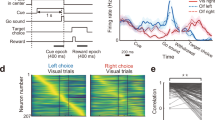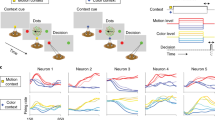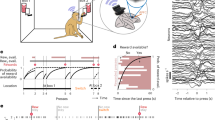Abstract
The posterior parietal cortex (PPC) receives diverse inputs and is involved in a dizzying array of behaviors. These many behaviors could rely on distinct categories of neurons specialized to represent particular variables or could rely on a single population of PPC neurons that is leveraged in different ways. To distinguish these possibilities, we evaluated rat PPC neurons recorded during multisensory decisions. Newly designed tests revealed that task parameters and temporal response features were distributed randomly across neurons, without evidence of categories. This suggests that PPC neurons constitute a dynamic network that is decoded according to the animal's present needs. To test for an additional signature of a dynamic network, we compared moments when behavioral demands differed: decision and movement. Our new state-space analysis revealed that the network explored different dimensions during decision and movement. These observations suggest that a single network of neurons can support the evolving behavioral demands of decision-making.
This is a preview of subscription content, access via your institution
Access options
Subscribe to this journal
Receive 12 print issues and online access
$209.00 per year
only $17.42 per issue
Buy this article
- Purchase on Springer Link
- Instant access to full article PDF
Prices may be subject to local taxes which are calculated during checkout





Similar content being viewed by others
References
Barlow, H.B. Summation and inhibition in the frog′s retina. J. Physiol. (Lond.) 119, 69–88 (1953).
Kuffler, S.W. Discharge patterns and functional organization of mammalian retina. J. Neurophysiol. 16, 37–68 (1953).
Britten, K.H., Newsome, W.T., Shadlen, M.N., Celebrini, S. & Movshon, J.A. A relationship between behavioral choice and the visual responses of neurons in macaque MT. Vis. Neurosci. 13, 87–100 (1996).
Nienborg, H. & Cumming, B.G. Macaque V2 neurons, but not V1 neurons, show choice-related activity. J. Neurosci. 26, 9567–9578 (2006).
Roitman, J.D. & Shadlen, M.N. Response of neurons in the lateral intraparietal area during a combined visual discrimination reaction time task. J. Neurosci. 22, 9475–9489 (2002).
Balan, P.F., Oristaglio, J., Schneider, D.M. & Gottlieb, J. Neuronal correlates of the set-size effect in monkey lateral intraparietal area. PLoS Biol. 6, e158 (2008).
Georgopoulos, A.P., Kalaska, J.F., Caminiti, R. & Massey, J.T. On the relations between the direction of two-dimensional arm movements and cell discharge in primate motor cortex. J. Neurosci. 2, 1527–1537 (1982).
Churchland, A.K., Kiani, R. & Shadlen, M.N. Decision-making with multiple alternatives. Nat. Neurosci. 11, 693–702 (2008).
Arimura, N., Nakayama, Y., Yamagata, T., Tanji, J. & Hoshi, E. Involvement of the globus pallidus in behavioral goal determination and action specification. J. Neurosci. 33, 13639–13653 (2013).
Viswanathan, P. & Nieder, A. Neuronal correlates of a visual “sense of number” in primate parietal and prefrontal cortices. Proc. Natl. Acad. Sci. USA 10.1073/pnas.1308141110 (2013).
Roth, E.D., Yu, X., Rao, G. & Knierim, J.J. Functional differences in the backward shifts of CA1 and CA3 place fields in novel and familiar environments. PLoS ONE 7, e36035 (2012).
Ganguli, S. & Sompolinsky, H. Compressed sensing, sparsity, and dimensionality in neuronal information processing and data analysis. Annu. Rev. Neurosci. 35, 485–508 (2012).
Salinas, E. Context-dependent selection of visuomotor maps. BMC Neurosci. 5, 47 (2004).
Pouget, A. & Sejnowski, T.J. Spatial transformations in the parietal cortex using basis functions. J. Cogn. Neurosci. 9, 222–237 (1997).
Rishel, C.A., Huang, G. & Freedman, D.J. Independent category and spatial encoding in parietal cortex. Neuron 77, 969–979 (2013).
Meister, M.L., Hennig, J.A. & Huk, A.C. Signal multiplexing and single-neuron computations in lateral intraparietal area during decision-making. J. Neurosci. 33, 2254–2267 (2013).
Freedman, D.J. & Assad, J.A. Distinct encoding of spatial and nonspatial visual information in parietal cortex. J. Neurosci. 29, 5671–5680 (2009).
Park, I.M., Meister, M.L., Huk, A.C. & Pillow, J.W. Encoding and decoding in parietal cortex during sensorimotor decision-making. Nat. Neurosci. 17, 1395–1403 (2014).
Rigotti, M. et al. The importance of mixed selectivity in complex cognitive tasks. Nature 497, 585–590 (2013).
Mante, V., Sussillo, D., Shenoy, K.V. & Newsome, W.T. Context-dependent computation by recurrent dynamics in prefrontal cortex. Nature 503, 78–84 (2013).
Harvey, C.D., Coen, P. & Tank, D.W. Choice-specific sequences in parietal cortex during a virtual-navigation decision task. Nature 484, 62–68 (2012).
Raposo, D., Sheppard, J.P., Schrater, P.R. & Churchland, A.K. Multisensory decision-making in rats and humans. J. Neurosci. 32, 3726–3735 (2012).
Sheppard, J.P., Raposo, D. & Churchland, A.K. Dynamic weighting of multisensory stimuli shapes decision-making in rats and humans. J. Vis. 13 10.1167/13.6.4 (2013).
Angelaki, D.E., Gu, Y. & DeAngelis, G.C. Multisensory integration: psychophysics, neurophysiology, and computation. Curr. Opin. Neurobiol. 19, 452–458 (2009).
Balan, P.F. & Gottlieb, J. Functional significance of nonspatial information in monkey lateral intraparietal area. J. Neurosci. 29, 8166–8176 (2009).
Li, C.S., Mazzoni, P. & Andersen, R.A. Effect of reversible inactivation of macaque lateral intraparietal area on visual and memory saccades. J. Neurophysiol. 81, 1827–1838 (1999).
Glickfeld, L.L., Histed, M.H. & Maunsell, J.H. Mouse primary visual cortex is used to detect both orientation and contrast changes. J. Neurosci. 33, 19416–19422 (2013).
Rogan, S.C. & Roth, B.L. Remote control of neuronal signaling. Pharmacol. Rev. 63, 291–315 (2011).
Reep, R.L., Chandler, H.C., King, V. & Corwin, J.V. Rat posterior parietal cortex: topography of corticocortical and thalamic connections. Exp. Brain Res. 100, 67–84 (1994).
Brunton, B.W., Botvinick, M.M. & Brody, C.D. Rats and humans can optimally accumulate evidence for decision-making. Science 340, 95–98 (2013).
Indyk, P. & Motwani, R. Approximate nearest neighbors: towards removing the curse of dimensionality. Proc. Annu. ACM Symp. Theory Comput. 30th 604–613 (1998).
Rust, N.C. & Dicarlo, J.J. Selectivity and tolerance (“invariance”) both increase as visual information propagates from cortical area V4 to IT. J. Neurosci. 30, 12978–12995 (2010).
Cortes, C. & Vapnik, V. Support-vector networks. Mach. Learn. 20, 273–297 (1995).
Kaufman, M.T., Churchland, M.M., Ryu, S.I. & Shenoy, K.V. Cortical activity in the null space: permitting preparation without movement. Nat. Neurosci. 10.1038/nn.3643 (2014).
Russo, G.S., Backus, D.A., Ye, S. & Crutcher, M.D. Neural activity in monkey dorsal and ventral cingulate motor areas: comparison with the supplementary motor area. J Neurophysiol. 88, 2612–2629 (2002).
Segraves, M.A. Activity of monkey frontal eye field neurons projecting to oculomotor regions of the pons. J. Neurophysiol. 68, 1967–1985 (1992).
Movshon, J.A. & Newsome, W.T. Visual response properties of striate cortical neurons projecting to area MT in macaque monkeys. J. Neurosci. 16, 7733–7741 (1996).
Chen, J.L., Carta, S., Soldado-Magraner, J., Schneider, B.L. & Helmchen, F. Behaviour-dependent recruitment of long-range projection neurons in somatosensory cortex. Nature 499, 336–340 (2013).
Churchland, A.K. & Lisberger, S.G. Discharge properties of MST neurons that project to the frontal pursuit area in macaque monkeys. J. Neurophysiol. 94, 1084–1090 (2005).
El-Shamayleh, Y., Kumbhani, R.D., Dhruv, N.T. & Movshon, J.A. Visual response properties of V1 neurons projecting to V2 in macaque. J. Neurosci. 33, 16594–16605 (2013).
Paré, M. & Wurtz, R.H. Progression in neuronal processing for saccadic eye movements from parietal cortex area lip to superior colliculus. J. Neurophysiol. 85, 2545–2562 (2001).
Sussillo, D. & Abbott, L.F. Generating coherent patterns of activity from chaotic neural networks. Neuron 63, 544–557 (2009).
Pagan, M., Urban, L.S., Wohl, M.P. & Rust, N.C. Signals in inferotemporal and perirhinal cortex suggest an untangling of visual target information. Nat. Neurosci. 16, 1132–1139 (2013).
Ghazanfar, A.A., Maier, J.X., Hoffman, K.L. & Logothetis, N.K. Multisensory integration of dynamic faces and voices in rhesus monkey auditory cortex. J. Neurosci. 25, 5004–5012 (2005).
Linden, J.F., Grunewald, A. & Andersen, R.A. Responses to auditory stimuli in macaque lateral intraparietal area. II. Behavioral modulation. J. Neurophysiol. 82, 343–358 (1999).
Mullette-Gillman, O.A., Cohen, Y.E. & Groh, J.M. Eye-centered, head-centered, and complex coding of visual and auditory targets in the intraparietal sulcus. J. Neurophysiol. 94, 2331–2352 (2005).
Kiani, R. & Shadlen, M.N. Representation of confidence associated with a decision by neurons in the parietal cortex. Science 324, 759–764 (2009).
Shams, L., Kamitani, Y. & Shimojo, S. Visual illusion induced by sound. Brain Res. Cogn. Brain Res. 14, 147–152 (2002).
Carandini, M. & Churchland, A.K. Probing perceptual decisions in rodents. Nat. Neurosci. 16, 824–831 (2013).
Wichmann, F.A. & Hill, N.J. The psychometric function: II. Bootstrap-based confidence intervals and sampling. Percept. Psychophys. 63, 1314–1329 (2001).
Feierstein, C.E., Quirk, M.C., Uchida, N., Sosulski, D.L. & Mainen, Z.F. Representation of spatial goals in rat orbitofrontal cortex. Neuron 51, 495–507 (2006).
Erlich, J.C., Bialek, M. & Brody, C.D. A cortical substrate for memory-guided orienting in the rat. Neuron 72, 330–343 (2011).
Breiman, L. Bagging predictors. Mach. Learn. 26 10.1023/A:1018054314350 (1996).
Nelder, J.A. & Wedderburn, R.W. Generalized linear models. J. R. Stat. Soc. [Ser. A] 135, 370–384 (1972).
Acknowledgements
We thank P. Znamenskiy, S. Jaramillo and T. Zador for technical advice, K. Rockland and A. Licata for help with histology, J. Sheppard and M. Ryan for help with electrophysiology and neural clustering, and M. Carandini and A. Rangel for providing input to early versions of the manuscript. Funding for this work was provided by US National Institutes of Health grants EY019072 and EY022979, the John Merck Fund, the McKnight Foundation, the Marie Robertson Memorial Fund of Cold Spring Harbor Laboratory, and a Swartz Foundation fellowship.
Author information
Authors and Affiliations
Contributions
D.R. and A.K.C. designed the experiments. D.R. performed the electrophysiology and inactivations. M.T.K. developed the PAIRS, variance alignment and decode analyses. D.R. and M.T.K. analyzed the data. A.K.C. wrote the paper. All authors discussed the results and implications and commented on the manuscript at all stages.
Corresponding author
Ethics declarations
Competing interests
The authors declare no competing financial interests.
Integrated supplementary information
Supplementary Figure 1 Rats are largely stationary during decision formation.
a, Head angle measured during a single session. Dashed: trials that ended in a high-rate choice; solid: trials that ended in a low-rate choice. Dashed/solid traces are largely overlapping during decision formation (while animals are still) but diverge during the time animals report their choices. b, Difference in head or body angle for trials ending in right vs. left choices (i.e., dashed minus solid traces in a). Each trace reflects the average of multiple sessions in which neurons were recorded: Stim, stimulus onset; Move, withdrawal time from center port.
Supplementary Figure 2 Inactivation impairs visual decisions.
a,b, Comparison of performance of 2 individual rats on saline (dark colors) vs. muscimol (light colors) for auditory (green), visual (blue) and multisensory trials (orange). Larger discrimination thresholds (σ, see Online Methods) indicate worse performance. In both animals, there was a significant change for visual performance (Rat 1: p = 0.006; Rat 2: p = 0.026) but no change for auditory (Rat 1: p = 0.72; Rat 2: p = 0.59) or multisensory (Rat 1: p = 0.24; Rat 2: p = 0.13) performance. c-d, Same as (a-b) but for separate inactivation experiments implemented with DREADD. The change in visual performance was individually significant in one rat (Rat 1: p = 0.026; Rat 2: p = 0.26). There was no statistically significant change on auditory (Rat 1: p = 0.90; Rat 2: p = 0.71) or multisensory (Rat 1: p = 0.81; Rat 2: p = 0.81) performance. e-g, Simulation to demonstrate that a large change in visual performance from inactivation leads to only a modest change in multisensory enhancement. e, Simulated control condition where matched auditory and visual performance leads to an improvement on multisensory trials. f, Same as (e) except that the visual performance is ~30% worse, simulating the effects of inactivation. Auditory performance is unchanged. g, A comparison of unisensory and multisensory performance for control and inactivation conditions. Multisensory enhancements were computed according to the rule of optimal multisensory integration. h-m, Inactivation decreases excess rate on visual trials. Excess rate was higher for all rats on visual trials with saline injection (dark blue) vs. inactivation (light blue). This effect was typically not observed on auditory trials: inactivation data (light green) overlap with saline data (dark green). Columns, rats.
Supplementary Figure 3 Histological sections from animals injected with DREADD.
a, Histological section showing DREADD expression in the PPC of one rat and the region that was manually selected for quantification of expression (ROI, green contour). b, Same as (a) but for brain section closer to the border between PPC and secondary visual cortex. c, Quantification of expression levels in PPC (green trace) and near the border of PPC (orange trace; see Online Methods). DREADD expression near the border of PPC was weak or absent. d, Quantification of DREADD expression levels (Online Methods). Heat map of average pixel intensity across columns of pixels for 7 brain sections, spanning 3.36 to 4.68 mm posterior to Bregma. Sections’ anterior-posterior locations were estimated using the Paxinos brain atlas. e-h, Same as (a-d) but for second rat injected with DREADD. i, 5 example sections from a rat brain injected with DREADD. DREADD expression was evident in PPC (4th section) but not elsewhere. Most anterior section is at left; sections become progressively more posterior from left to right.
Supplementary Figure 4 Responses from 12 example neurons.
PSTHs showing the responses of 12 neurons, grouped by both modality (color) and choice (line style). Analysis was restricted to correct trials only. Responses are aligned both to the onset of the stimulus (left subpanels) and the time of the movement (right subpanels).
Supplementary Figure 5 Choice preference/divergence are stronger on multisensory trials and easy unisensory trials.
a, Magnitude and time course of choice divergence for multisensory trials was similar to that seen in auditory/visual trials (Fig. 2e). b, Choice divergence was stronger on multisensory trials than unisensory. Abscissa: time relative to the rat’s movement to report the decision. Ordinate: the difference in choice divergence for multisensory versus visual trials. Values > 0 indicate stronger divergence on multisensory trials. c, Same as (b) but comparing multisensory with auditory trials. d-f, Choice divergence was significantly stronger on easy trials (rates > 2 events/s from the category boundary) compared to difficult trials (rates that were 1 or 2 events/s from the category boundary). g, Histogram of choice preference for multisensory trials, measured 200 ms before decision end. 39.8% of neurons (of 236 total) had significantly nonzero choice preference. h, Auditory choice preference was strongly correlated with visual choice preference, N = 262 neurons, r = 0.74, p < 10-4). Shading indicates significance. i, Multisensory choice preference was strongly correlated with both auditory choice preference (green symbols; N = 236 neurons, r = 0.668, p < 0.001) and visual choice preference (blue symbols; N = 236 neurons, r = 0.807, p < 0.001). Shading indicates significance.
Supplementary Figure 6 Neither choice/modality nor time-varying firing rate patterns define clusters.
a, Left: Example data showing the linear (choice) and interaction (choice x modality) terms from a regression analysis performed on individual neurons in Rat 4. Red cross shows the median value. Histogram shows the difference between the two values. The linear component was greater than the nonlinear component for this animal (p < 0.001, two-sided sign test). This was true for all rats tested, though the difference was variable and did not always reach significance: linear > nonlinear, rat 1: p = 0.065; rat 2: p = 0.775; rat 3: p = 0.044; rat 5: p = 0.036. Right: Same as left, except that the linear component is modality rather than choice. Again, the linear component was greater than the nonlinear component (p < 0.001) in the example. Other animals: linear > nonlinear, Rat 1: p = 0.132; Rat 2: p = 0.044; Rat 3: p = 0.253; Rat 5: p = 0.766. b, The eight principal components used in the PAIRS analysis. These were generated from the population data (N = 94 neurons) from one animal (Rat 4). Colors indicate modality; dashed lines: data from high rate trials; solid lines: data from low rate trials. c, Data from the PAIRS analysis for the four additional animals not shown in Figure 3.
Supplementary Figure 7 Choice can be estimated on multisensory trials, even when the decoder is trained on data from unisensory trials.
a, Weighted sums of neural responses; weights were chosen by the classifier. Blue, visual; green, auditory; orange, multisensory; dashed lines: high-rate trials; solid lines: low-rate trials. Data from unisensory trials is the same as in Figure 4a. Data from Rat 4, N = 94 neurons. b, The choice decoder could correctly classify responses as left vs. right on multisensory trials where the rat was successful (bright red traces, one per rat). Decoder performance was significantly better than chance for all animals tested. Rat 5 was excluded from this analysis because of insufficient days on which multisensory trials were presented. c, Same as (a) but for the modality decoder.
Supplementary information
Supplementary Text and Figures
Supplementary Figures 1–7 (PDF 1211 kb)
Supplementary Methods Checklist
(PDF 419 kb)
Rights and permissions
About this article
Cite this article
Raposo, D., Kaufman, M. & Churchland, A. A category-free neural population supports evolving demands during decision-making. Nat Neurosci 17, 1784–1792 (2014). https://doi.org/10.1038/nn.3865
Received:
Accepted:
Published:
Issue Date:
DOI: https://doi.org/10.1038/nn.3865
This article is cited by
-
Behavior-relevant top-down cross-modal predictions in mouse neocortex
Nature Neuroscience (2024)
-
Synaptic wiring motifs in posterior parietal cortex support decision-making
Nature (2024)
-
Dynamical latent state computation in the male macaque posterior parietal cortex
Nature Communications (2023)
-
A cell-type-specific error-correction signal in the posterior parietal cortex
Nature (2023)
-
The rat frontal orienting field dynamically encodes value for economic decisions under risk
Nature Neuroscience (2023)



